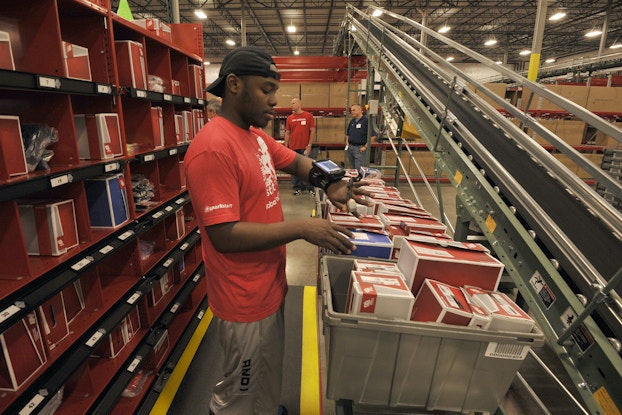
Why it matters:
- Supply chains are becoming less linear as e-commerce demands grow and stores become fulfillment centers.
- A hefty 65% of retailers established or expanded their local and domestic manufacturing sources in order to gain better control of their supply chain during the COVID-19 pandemic.
- Some apparel companies are moving manufacturing from overseas to the U.S. to operate closer to their consumer markets.
The COVID-19 pandemic fostered innovation and new ways of thinking about the manufacturing, warehousing and distribution of consumer goods, according to speakers at a recent webinar presented by Coresight Research and Blue Yonder attended by CO—.
Like nearly all consumer goods companies around the world, apparel manufacturer and retailer PVH Corp., parent of brands that include Tommy Hilfiger and Calvin Klein, was forced to rethink its processes in the past year, said Sarah Clarke, executive vice president, PVH Supply North America. Consumers turned to e-commerce in droves to buy products, just as big-box chains that sell the company’s products, such as Costco and Target, considered essential retailers, continued to generate strong in-store sales as well, she said.

Interested in a small business membership?
Find out how the U.S. Chamber of Commerce can help your company grow and thrive in today's rapidly-evolving business environment. Connect with our team to learn how a small business membership can benefit your bottom line and help you achieve your goals.
However, other retailing and manufacturing operations in the 190 countries around the world where PVH conducts business were under various stages of lockdown throughout the year, driving fluctuations in both supply and demand. Compounding the supply chain issues brought on by the pandemic in 2020 were factors such as the tariffs on imports from China and the Brexit negotiations.
“Supply chain is becoming an outdated term,” said Clarke. “It’s no longer linked in a chain and linear. It’s a messy, messy network.”
In order to meet consumer demands for e-commerce, the company, for the first time, initiated fulfillment from its Tommy Hilfiger stores in Europe.
“With increased interest in e-commerce, we had to figure out ways to get products to people that we didn’t do before,” said Clarke.
Likewise, athletic footwear manufacturer New Balance saw its business shift sharply to e-commerce in 2020, with 50% of its volume selling through digital channels, said Joe Preston, president and CEO. [Read here on simplifying inventory management.]
[The] research also revealed that retailers plan to invest in technology to improve their supply chain operations in 2021, with 62% citing solutions for assortment, inventory, logistics and warehousing as a primary focus of their planned tech spending.
Repurposing retail footprints to accommodate the e-commerce boom
The trend toward e-commerce is driving New Balance to rethink its retail footprint, which includes about 200 stores in the U.S., and about 3,500 in other countries around the world. Traditionally, individual stores have been evaluated based on sales at the register and profitability. However, with product returns being a significant factor of buying apparel and footwear online, and with the increasing need for e-commerce fulfillment solutions, New Balance is exploring new ways to assess the value of its retail locations.
“We are looking all around the globe at locations not only where we can have a viable store, but also servicing that community to make sure that we are meeting the needs of that consumer, getting them the product as soon as they want the product, and also smoothing out that return process,” Preston said.
Tractor Supply, a national retailer of goods for farmers, has also adapted its 1,923-store network to the increasing demand for online ordering. It has established a drive-through area next to its stores to support the buy online, pickup in-store model (BOPIS), said Colin Yankee, chief supply chain officer of the chain.
“We have seen a massive shift in digital engagement,” he said. “Things we thought would take two to three years to reach maturity have happened in two to three weeks.”
The company saw a large increase in demand overall during the year, as more consumers moved to suburban and rural areas, and took on new pastimes, such as raising chickens. The increased demand, combined with changes in the way customers shopped and orders were fulfilled, led the company to increase its staffing levels by more than 50% in 2020, from 30,000 employees at the start of the year to 46,000.
Orvis, a manufacturer and retailer of fly-fishing gear and other outdoors equipment and apparel, also saw a sharp rise in consumer demand during the pandemic as consumers reconnected with nature, said David Finnegan, chief experience officer at Orvis.
He said the company is in the process of upgrading its digital ecosystem to enhance the experience for consumers, as well as optimize inventories to ensure that products are in the right place at the right time to meet customer demands.
[More here on instituting a supply chain backup plan.]

Bringing manufacturing and warehousing hubs closer to consumers to speed service
A key focus of the discussion centered around bringing manufacturing and warehousing closer to consumers to improve speed of service and minimize the risks of sourcing from far-flung regions of the world. The pandemic caused massive supply chain issues for many retailers when some regions shut down manufacturing, and others, such as the U.S. and Europe, shuttered some retailing, leaving shiploads of inbound product without a place to go.
Steve Lamar, president and CEO of the American Apparel & Footwear Association, said companies had already been moving some manufacturing activities to the U.S. from overseas. This not only has the potential to generate goodwill among consumers, but can also make good business sense in some cases because of the proximity to consumers and the minimized risk of supply chain disruption.
“COVID has really accelerated these trends,” he said.
According to the Retail Localization & Agility Survey conducted by Coresight and Blue Yonder, 65% of retailers established or expanded their local and domestic manufacturing sources in order to gain better control of their supply chain during the COVID-19 pandemic. In addition, the research also revealed that retailers plan to invest in technology to improve their supply chain operations in 2021, with 62% citing solutions for assortment, inventory, logistics and warehousing as a primary focus of their planned tech spending.
CO— aims to bring you inspiration from leading respected experts. However, before making any business decision, you should consult a professional who can advise you based on your individual situation.
Follow us on Instagram for more expert tips & business owners stories.
CO—is committed to helping you start, run and grow your small business. Learn more about the benefits of small business membership in the U.S. Chamber of Commerce, here.







